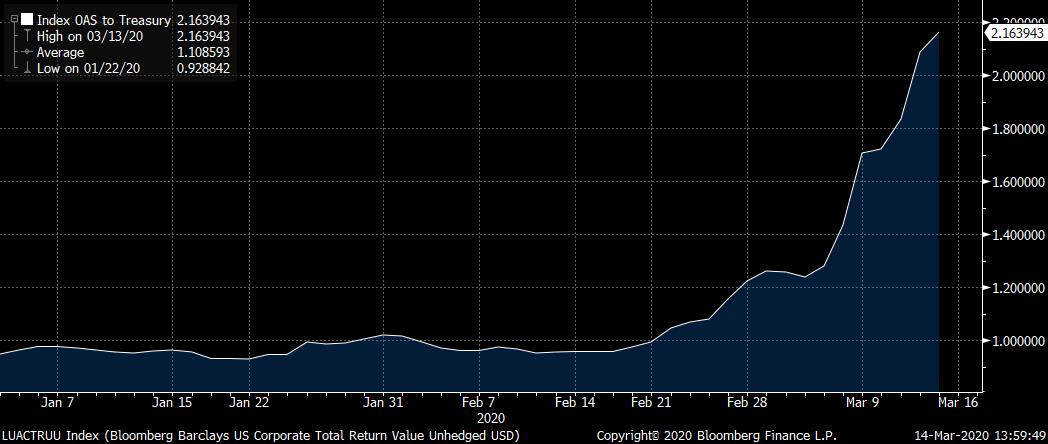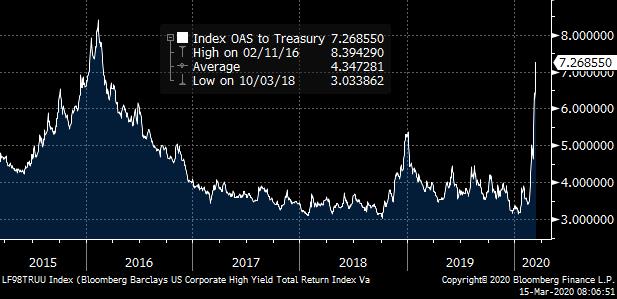Fund Flows & Issuance: According to a Wells Fargo report, flows week to date were +$2.2 billion and year to date flows stand at -$1.7 billion. New issuance for the week was $17.3 billion and year to date issuance is at $98.6 billion.
(Bloomberg) High Yield Market Highlights
- The junk bond market is likely to see more supply with stock futures rising and oil steadying. Titanium dioxide producer Tronox is set to price a $400 million deal Friday, while Delta Air Lines is seeking to raise about $3 billion from loans and bonds that may price early next week.
- Issuers have been racing to the market, mostly to shore up liquidity. Over $17b of volume has priced this week and the month’s tally is now over $33 billion.
- New issues have been well received
- Streaming giant Netflix pulled in more than $5b of orders on its $500m offering and priced it at a yield of 3.625%, among the lowest ever seen in the U.S. high-yield bond market and in line with prices typically offered on investment-grade bonds.
- Gap drew more than $8b of demand for a $2.25b deal that was increased from $2b. Demand was skewed to the five-and seven year tranches, according to people familiar with the matter
- XPO Logistics increased the size of its offering by $100m to $850m and priced it at the lower end of talk. Orders had reached more than $4b by early afternoon
- US Foods’ $1b deal was upsized from $800m as orders topped $3.2b
- Investors poured more cash into junk bonds with retail funds reporting an inflow of $2.2b for week, after seeing a record weekly inflow last week. This was the fourth straight week of inflows.
- Junk bond yields and spreads were a touch weaker Thursday. Spreads have widened 42bps since Monday to 762bps over Treasuries
- Index returns have been negative in three of the last four sessions
(Bloomberg) Oil Plunges Below Zero for First Time in Unprecedented Wipeout
- Of all the wild, unprecedented swings in financial markets since the coronavirus pandemic broke out, none has been more jaw-dropping than Monday’s collapse in a key segment of U.S. oil trading.
- The price on the futures contract for West Texas crude that was due to expire Tuesday fell into negative territory — minus $40.32 a barrel at the low. That’s right, sellers were actually paying buyers to take the stuff off their hands. The reason: with the pandemic bringing the economy to a standstill, there is so much unused oil sloshing around that American energy companies have run out of room to store it. And if there’s no place to put the oil, no one wants a crude contract that is about to come due.
- Underscoring just how acute the concern is over the lack of immediate storage space, the price on the futures contract due a month later settled at $20.43 per barrel. That gap between the two contracts is by far the biggest ever.
- “The May crude oil contract is going out not with a whimper, but a primal scream,” said Daniel Yergin, a Pulitzer Prize-winning oil historian and vice chairman of IHS Markit Ltd.
- “There is little to prevent the physical market from the further acute downside path over the near term,” said Michael Tran, managing director of global energy strategy at RBC Capital Markets. “Refiners are rejecting barrels at a historic pace and with U.S. storage levels sprinting to the brim, market forces will inflict further pain until either we hit rock bottom, or COVID clears, whichever comes first, but it looks like the former.”
(Bloomberg) Distressed Energy Debt Jumped by $11 Billion Amid Oil Collapse
- Distressed debt in the U.S. energy sector has jumped to $190 billion, up more than $11 billion in less than a week, as oil prices tumbled below zero.
- The collapse of oil makes investors nervous about whether energy companies will be able to repay their debt. Energy sector distressed debt — bonds that yield at least 10 percentage points over Treasuries and loans that trade for less than 80 cents on the dollar — totaled $190 billion on Tuesday, according to data compiled by Bloomberg. That’s up from $179 billion on April 15.
- Distressed debt surged to the highest since 2008 last month as markets sold off on coronavirus fears and the oil price halved. The amount outstanding fell by nearly 50% after the Federal Reserve announced plans to buy investment grade and some high-yield debt, boosting credit markets. But after oil fell below zero, distressed debt in the energy sector could retest recent highs.
- Oil giant Occidental Petroleum Corp. has more distressed debt than any other U.S. company, with its $21 billion tally nearly double that of the next highest on the list. Oil companies made up five of the top 10 issuers with the most distressed debt as of Tuesday.


